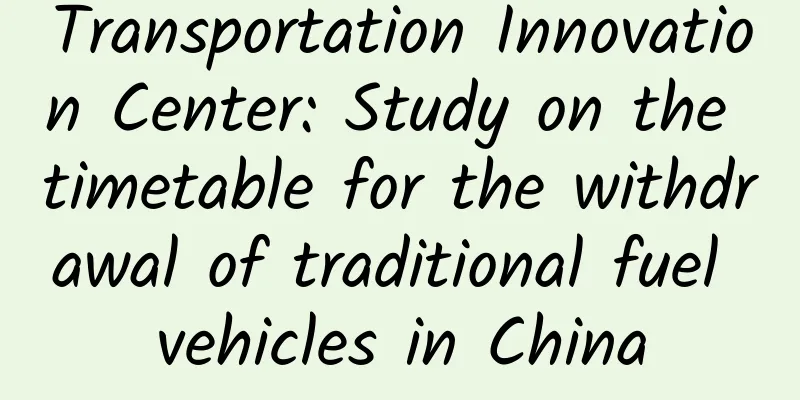Transportation Innovation Center: Study on the timetable for the withdrawal of traditional fuel vehicles in China

|
Download the report: Add 199IT official WeChat [i199it], reply with the keyword [Research on the Exit Timetable of Traditional Fuel Vehicles in China] The report, based on an in-depth study of the ban on the sale of traditional fuel vehicles at home and abroad, the development trend of new energy vehicle technology, the role of the market economy, oil supply security, environmental protection and carbon emission reduction, proposed a design plan for the replacement and withdrawal of traditional fuel vehicles in China, and analyzed its uncertainties and risks. Experts from China Automotive Technology Research Center, China International Engineering Consulting Co., Ltd., Natural Resources Defense Council (NRDC) and other institutions commented on the report. Why do you want to quit? The report believes that the gradual withdrawal of traditional fuel vehicles is an irreversible global trend. Driven by factors such as energy conservation and emission reduction, pollution control and the transformation of the automobile industry, since 2016, many countries, regions and cities have successively announced that they will ban the sale of fuel vehicles. Although the ban on the sale of fuel vehicles in most countries and regions is still mainly based on the statements of the competent authorities, Norway, the Netherlands, the United Kingdom and other countries have proposed a specific timetable for the ban on the sale of fuel vehicles through bills, national planning documents or transportation department strategy books. Some automobile companies have also proposed corresponding development strategies in response to this trend. For example, Volkswagen plans to electrify all its models by 2030 and completely stop selling traditional fuel vehicles; BAIC Group proposed that its own brands will completely stop selling fuel vehicles in China in 2025. The report believes that setting a timetable for the ban on the sale of fuel vehicles is to play a guiding role in policies and corporate production plans, and to give society a clear market signal that the gradual replacement and withdrawal of traditional fuel vehicles is an irreversible global trend. Based on domestic and foreign experience, the relevant policies formulated by the government will play a key guiding role. Investors need to make wise decisions, enterprises need to make production deployments in advance, and consumers need to change their consumption perceptions and patterns. Some cities and regions in China have taken the lead in launching this process. In March 2019, Hainan Province issued the "Clean Energy Vehicle Development Plan", becoming the first region in the country to propose clean energy goals and roadmaps for vehicles in all segments; many automobile companies have also proactively launched a timetable and roadmap for the withdrawal of their own brand fuel vehicles. The report believes that the biggest driving force for China to develop new energy vehicles and gradually withdraw from traditional fuel vehicles is to strengthen air pollution prevention and control efforts and improve air quality. The national "Three-Year Action Plan to Win the Blue Sky Defense War" has required all regions to issue and implement air pollution prevention and control regulations and action plans. Among them, the development of new energy vehicles is an important means of preventing and controlling road traffic pollution. Another important driving force is to reduce oil consumption and ensure the security of national energy supply. In 2018, China's dependence on foreign oil has reached 70.9%, and there is a trend of continued rise. As of the end of 2018, China's automobile production and sales have ranked first in the world for 10 consecutive years, with a car ownership of more than 200 million vehicles. The oil consumption of passenger cars and commercial vehicles accounts for 42% of China's total oil consumption. It is expected that China's car ownership will continue to grow. If traditional fuel vehicles are relied on to meet this demand, oil consumption will increase significantly, exacerbating energy supply risks. The scenario analysis of the Oil Control Research Project pointed out that China's total oil consumption will peak around 2025. To achieve this goal, the gradual withdrawal of traditional fuel vehicles is one of the most important strategic deployments. When and how to exit? The report suggests that the ban on sales and withdrawal of traditional fuel vehicles can be implemented gradually in accordance with the steps of "dividing regions, models and stages". Based on factors such as economic development, per capita car ownership, new energy vehicle industry development, and charging infrastructure construction in different regions, the report divides the Chinese mainland into four levels: Level I is super-large cities (such as Beijing, Shanghai, and Shenzhen) and functional demonstration areas (such as Hainan and Xiong'an); Level II is cities with traditional car restrictions and purchase restrictions and provincial capital cities in key areas of the blue sky defense war; Level III is mainly key areas of the blue sky defense war and new energy vehicle industry cluster areas (such as North China, the Yangtze River Delta, the Pan-Pearl River Delta, and the Fenwei Plain); Level IV (such as the Northwest, Northeast, and Southwest) follows closely. The process of withdrawing traditional fuel vehicles is advancing from point to surface. The report divides fuel vehicles into five categories according to the difficulty of exiting the market, and arranges their exit priority order. Vehicle types such as buses, taxis, time-sharing and online car-hailing, postal and light logistics vehicles, airport and port vehicles, sanitation vehicles, and official vehicles should be replaced or withdrawn first, followed by private cars and ordinary commercial vehicles. In cities such as Beijing, Shanghai, and Shenzhen in Tier I and Guangzhou, Tianjin, and Nanjing in Tier II, private cars should be completely withdrawn by 2030. For example, Shenzhen has become the first city in the world to achieve full electrification of buses and taxis. In the process of withdrawing traditional fuel vehicles, Shenzhen is at the forefront of China. The report recommends that light trucks, medium trucks, and heavy trucks in road transportation should formulate a withdrawal schedule based on the difficulty of their electric technology development and application. Driven by the joint efforts of market and policy means, China is expected to achieve a complete withdrawal of traditional fuel vehicles by 2050. What impact will it have? The report predicts that with the gradual withdrawal of traditional fuel vehicles in China, diesel consumption has reached its peak and entered a consumption plateau period, and gasoline consumption will reach its peak around 2025. After that, gasoline and diesel consumption will continue to decline, falling by 55% and 80% from the peak in 2040 and 2050 respectively. China's terminal greenhouse gas emissions from fuel vehicles are expected to peak in 2024, and terminal greenhouse gas emissions will drop by 51% and 77% from the peak in 2040 and 2050 respectively. Uncertainties and suggestions The report finally pointed out that considering uncertain factors such as the supply of rare metal resources such as lithium, battery recycling and charging infrastructure construction, transformation of traditional car companies, external environment, and major technological breakthroughs, the withdrawal and progress of traditional fuel vehicles in China are highly uncertain. The report puts forward policy recommendations aimed at promoting the withdrawal of traditional fuel vehicles in China, including the establishment of a cross-departmental and cross-industry expert review committee to thoroughly review the feasibility and timetable of banning the sale of traditional fuel vehicles, and the establishment of a multi-departmental coordinated promotion mechanism; building a legal basis and reflecting the target priority of the withdrawal of traditional fuel vehicles at a certain stage in important regulatory documents; encouraging qualified regions to take the lead and introduce incentive mechanisms; guiding the transformation of the traditional automobile industry; building a sound evaluation mechanism to conduct regular evaluations of the withdrawal of traditional fuel vehicles and the electrification process; and on the consumer side, it is also necessary to study and formulate policies for the management of new energy vehicle traffic and the withdrawal of existing fuel vehicles. An Feng, founder and executive director of the Energy and Transportation Innovation Center, believes that in addition to the market, policies are the main tool for the withdrawal of traditional fuel vehicles. It is necessary to formulate sound implementation rules, continuously evaluate the policy effects and influence, and adjust the original plan. The study of the timetable for the withdrawal of fuel vehicles cannot be a "one-size-fits-all" approach. There must be solid and forward-looking research for reference by policymakers. Investors, manufacturers and consumers will also need sufficient time to adjust their strategies and plans. At the same time, we must also consider the possibility of "breakthroughs" in automobile technology and energy technology. New energy vehicle technology breakthroughs and business model innovations will accelerate the withdrawal of traditional fuel vehicles. In addition, more optimized low-carbon transportation system planning and shared travel will also accelerate the withdrawal of traditional fuel vehicles in China. The Oil Control Research Project will work with more institutions to continue to conduct research on the comprehensive low-carbonization of the transportation system, and will select specific typical cities and regions to conduct in-depth analysis of the roadmap for the withdrawal of fuel vehicles, so that the withdrawal of traditional fuel vehicles in the region can be faster than the national time limit. Based on more in-depth research in the future, the Oil Control Research Project will continue to improve the timetable for the withdrawal of traditional fuel vehicles. Download the report: Add 199IT official WeChat [i199it], reply with the keyword [Research on the Exit Timetable of Traditional Fuel Vehicles in China] |
<<: US brokerage firm upgrades Intel rating, says PC market may be over
>>: Intel thinks the 'Jellyfish' graphics card virus isn't that scary
Recommend
In ancient times, fishtail copper tiles were used to prevent lightning, and today there are "lightning-absorbing artifacts": Why is China's lightning protection technology leading the world?
“The storm is coming” and “the dark clouds are pr...
3 tips for high-conversion promotion creativity!
What kind of creative has a high click-through ra...
Top Thai media group visits GAC Aion and praises it as the "most valuable" Chinese brand
On February 28, 2024, the "Top Thai Media Gr...
Struggling domestic operating systems
How many Chinese companies are developing domesti...
How to promote Kuaishou? Share the promotion method of Kuaishou live broadcast!
How to promote Kuaishou live streaming ? In 4 yea...
App Growth | NetEase Cloud Music’s Growth Path!
This article summarizes several growth methods of...
To optimize the effect of GuangDianTong, you must pay attention to these 8 small details!
Guangdiantong is one of Tencent’s two major infor...
This kind of "fly" can not only be caught by hand, but also eaten
If there is a kind of "fly" that is lar...
Flash is on its way out: Microsoft Edge browser blocks its use
Earlier today, Microsoft brought users the Window...
True high-quality watering: When irrigation meets high-tech
In order to ensure the country's food securit...
Epidemic prevention requirements for returning home during the Spring Festival, summary of policies in 31 provinces, autonomous regions and municipalities
All along All regions are taking into account the...
Amazon's entry into Tmall will affect overseas shopping landscape
Last night, during the Lantern Festival, Amazon C...
Mars also has its own New Year? Future Martians, come and see how to celebrate the Martian New Year
Image generation: Doubao AI The Martian New Year ...
Asking for water from the sea is no longer a dream? my country can desalinate more than 1.6 million tons of seawater every day!
Author: Duan Yuechu Desalination technology is an...
Why do some people suffer from rhinitis repeatedly?
It is the season of transition from winter to spr...







![Tik Tok live broadcast room 3D anchor AI virtual character builds anime image without showing face live broadcast [virtual live broadcast script + tutorial]](/upload/images/67cbfd5899747.webp)

